Dell Technologies Bundle
How Has Dell Technologies Mastered Sales and Marketing?
From its revolutionary direct-to-consumer model to its current status as a global technology solutions provider, Dell Technologies' journey is a masterclass in strategic adaptation. Founded in 1984, the company's initial focus on personalized computer builds fundamentally changed the industry. This evolution reveals a fascinating narrative of how Dell has navigated market shifts and maintained its competitive edge.
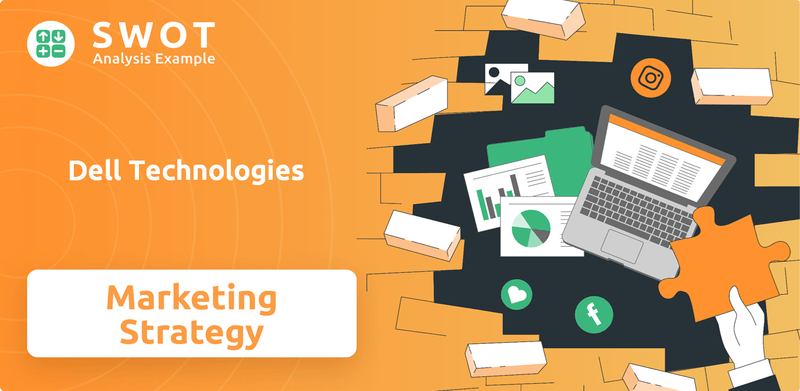
This exploration will dissect the core elements of Dell Technologies' strategy, from its sales channels and marketing tactics to its brand positioning in a fiercely competitive landscape. Understanding the Dell Technologies SWOT Analysis is crucial, as we examine how Dell Technologies effectively reaches its diverse target audience and maintains its market leadership. We'll also analyze key aspects of its Dell sales strategy, Dell marketing strategy, and overall Dell Technologies strategy, providing insights into how it generates revenue and adapts to future marketing trends.
How Does Dell Technologies Reach Its Customers?
The sales and marketing strategy of Dell Technologies relies on a multifaceted approach, utilizing diverse sales channels to reach a broad customer base. This strategy encompasses both online and offline methods, catering to consumers, small businesses, and large enterprises. The company's approach is designed to ensure market penetration and customer satisfaction.
A cornerstone of Dell's sales strategy is its e-commerce platform, Dell.com, which provides a direct-to-consumer and business-to-business purchasing experience. This online channel allows for extensive product customization and direct engagement. Furthermore, Dell has expanded its reach through an extensive network of channel partners, including value-added resellers, distributors, and system integrators. These partnerships are crucial for reaching segments that require specialized integration and localized support.
The evolution of Dell's sales channels reflects a strategic shift towards an omnichannel approach, integrating its direct sales force with its partner ecosystem. This approach enables the company to adapt to diverse customer preferences and market complexities. This strategic shift has been instrumental in Dell maintaining its significant market share in various IT segments.
Dell.com serves as a primary direct sales channel, offering extensive product customization and direct engagement. The online platform is continually optimized for user experience and efficient order fulfillment. This channel is crucial for driving direct sales and providing a comprehensive customer experience.
Dell leverages an extensive network of channel partners, including value-added resellers, distributors, and system integrators. These partners are essential for reaching segments requiring specialized integration and localized support. This approach helps expand market reach and cater to diverse customer needs.
Dedicated direct sales teams manage key partnerships with large enterprise clients and government agencies, ensuring tailored solutions and support. This personalized approach is critical for maintaining strong relationships and meeting specific client requirements. These teams focus on high-value accounts.
Dell's products are available through major electronics retailers, providing a tangible touchpoint for consumers who prefer to experience products before purchasing. This expands accessibility and supports the customer journey. It allows for increased visibility and sales.
Dell's sales strategy involves multiple channels to maximize market penetration and cater to diverse customer needs. The direct sales model, combined with a robust partner network, allows for a comprehensive approach. This diversified approach is essential for maintaining a competitive edge in the IT market.
- E-commerce: Provides direct access and customization options.
- Channel Partners: Extends reach and offers specialized support.
- Direct Sales Teams: Manages key accounts and provides tailored solutions.
- Retail Partnerships: Increases accessibility and provides a tangible customer experience.
Dell Technologies SWOT Analysis
- Complete SWOT Breakdown
- Fully Customizable
- Editable in Excel & Word
- Professional Formatting
- Investor-Ready Format
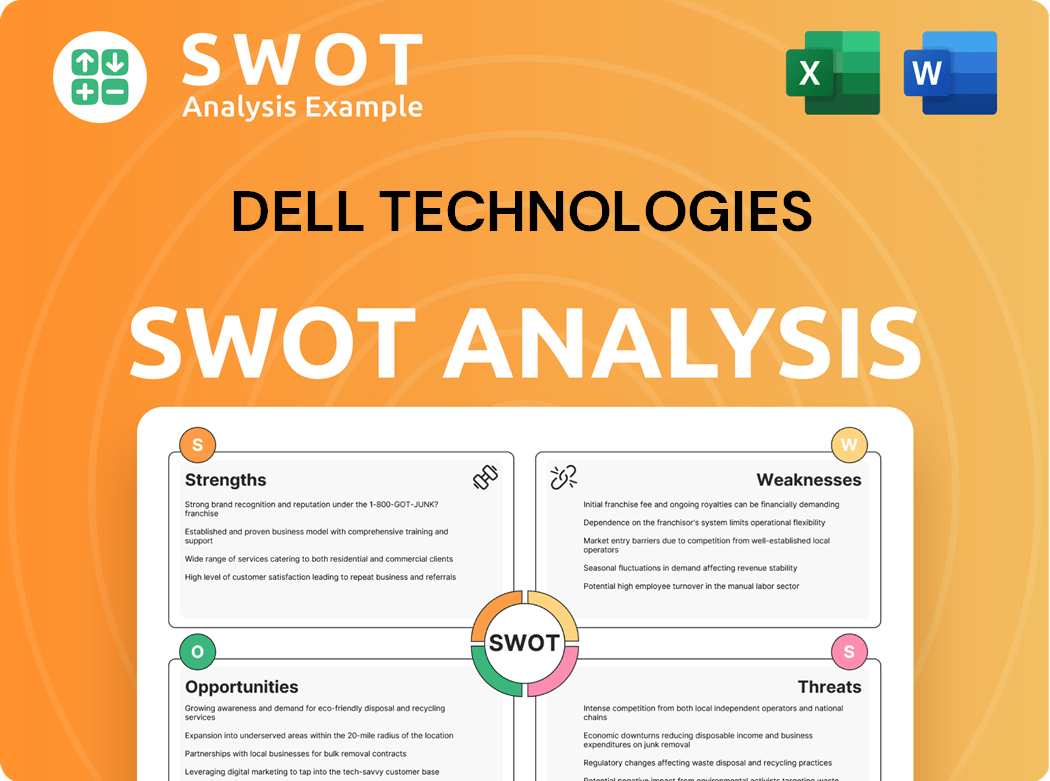
What Marketing Tactics Does Dell Technologies Use?
The marketing tactics of the company are multifaceted, integrating digital and traditional strategies to boost brand recognition, create leads, and boost sales across its extensive product and service offerings. The company's approach is data-driven, utilizing analytics to personalize marketing messages and refine targeting strategies, reflecting its commitment to innovation and understanding its diverse customer needs.
Digital marketing plays a pivotal role, with a focus on content marketing, SEO, and paid advertising. Content marketing involves producing whitepapers and case studies to position the company as a thought leader. SEO ensures high visibility for its products, especially for commercial AI PCs, and paid advertising campaigns are precisely targeted based on customer segmentation to optimize ad spend. Email marketing is also a key tool for nurturing leads and offering personalized promotions.
The company strategically uses social media for brand engagement and customer support, promoting sustainability initiatives. While digital tactics are dominant, the company still employs traditional media for brand-building. The company's marketing mix has evolved, moving towards more integrated, personalized, and data-centric campaigns.
Content marketing is a cornerstone of the company's digital strategy. Extensive whitepapers, case studies, and blog posts are produced to address IT challenges, positioning the company as a thought leader. This approach is crucial for showcasing expertise in areas like AI infrastructure and hybrid cloud solutions.
SEO is rigorously applied to ensure high visibility for products and solutions, particularly for cutting-edge technologies. This includes optimizing content and website structure to improve search engine rankings. The focus is on driving organic traffic and increasing brand visibility.
Paid advertising campaigns are precisely targeted based on customer segmentation. Data analytics are used to optimize ad spend and achieve high conversion rates. This includes campaigns across search engines and social media platforms.
Email marketing remains a vital tool for nurturing leads, announcing new products, and offering personalized promotions. Campaigns are often segmented by customer type (consumer, small business, enterprise) and purchase history. This ensures relevant and timely communication.
Social media platforms are strategically used for brand engagement, customer support, and promoting sustainability initiatives. This includes campaigns to highlight its goal to use 50% recycled or renewable content in all products by 2030. Social media is a key channel for direct customer interaction.
Traditional media is still utilized, particularly for brand-building and reaching broader audiences. Strategic placements in technology publications and industry events are employed. This complements the digital efforts to enhance overall brand presence.
The company's approach to data-driven marketing is highly advanced, utilizing robust analytics platforms to track customer journeys, personalize marketing messages, and refine targeting strategies. This includes leveraging insights from its vast customer base to inform product development and tailor marketing efforts. The evolution of the company's marketing mix reflects its commitment to innovation and understanding its diverse customer needs. For more details, you can read about the Growth Strategy of Dell Technologies.
The company's marketing strategy encompasses a comprehensive approach, integrating various elements to reach its target audience effectively. This includes a blend of digital and traditional marketing activities.
- Product: The company offers a diverse product portfolio, including PCs, servers, storage solutions, and software.
- Price: Pricing strategies vary based on the product and target market, with options ranging from value-oriented to premium.
- Place (Distribution): Products are distributed through direct sales, online channels, and partnerships with retailers and distributors.
- Promotion: Promotion includes content marketing, SEO, paid advertising, email marketing, social media, and traditional media.
Dell Technologies PESTLE Analysis
- Covers All 6 PESTLE Categories
- No Research Needed – Save Hours of Work
- Built by Experts, Trusted by Consultants
- Instant Download, Ready to Use
- 100% Editable, Fully Customizable
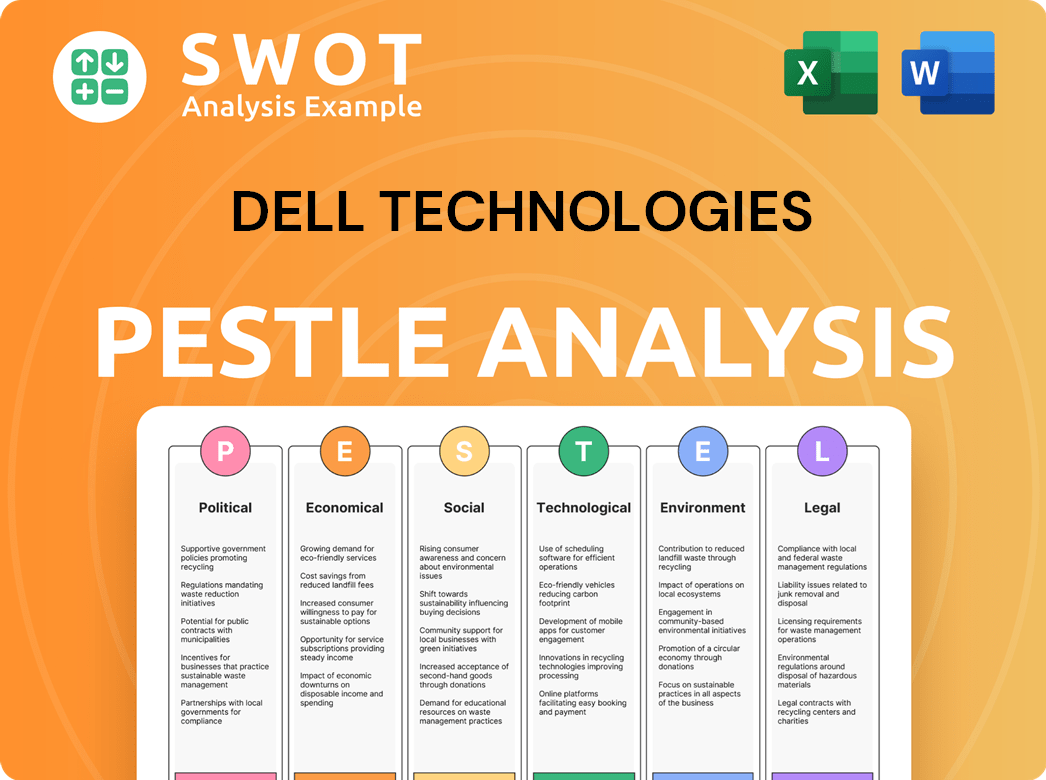
How Is Dell Technologies Positioned in the Market?
Dell Technologies positions itself as a technology solutions provider, emphasizing its role in empowering progress and enabling human potential. Its brand identity is built on reliability, performance, and a customer-centric approach. This involves tailored solutions for various users, from individuals to large enterprises. The company's visual identity is characterized by a clean, professional aesthetic, often showcasing sleek designs and a focus on functionality.
The brand's tone of voice is authoritative, knowledgeable, and forward-looking, aiming to inspire confidence and demonstrate leadership in the technology sector. The company promises a seamless customer experience, supported by its direct sales model and comprehensive support services, which have been a significant differentiator. This approach helps to solidify its position in the competitive tech market.
Dell's brand strategy focuses on innovation and value, appealing to a wide audience. For consumers, this means cutting-edge performance and design in laptops and desktops. For businesses, it translates to robust, scalable, and secure IT infrastructure solutions. The company's commitment to sustainability is also a key part of its brand appeal. Dell consistently ranks among top technology brands, recognized for its reliable products and strong customer service. To learn more about its target audience, you can read about the Target Market of Dell Technologies.
Dell's sales strategy focuses on direct sales, online channels, and partnerships. The direct sales model allows for customized solutions and strong customer relationships. Online channels provide broad reach and accessibility. Partnerships extend market reach and offer specialized expertise.
The marketing strategy includes digital marketing, content creation, and social media engagement. Digital marketing drives online visibility and customer acquisition. Content marketing educates and engages the target audience. Social media fosters brand awareness and customer interaction.
Dell's overall strategy emphasizes innovation, customer satisfaction, and market expansion. Innovation drives product development and competitive advantage. Customer satisfaction builds loyalty and positive brand reputation. Market expansion involves entering new markets and segments.
The business model incorporates direct sales, channel partnerships, and a focus on enterprise solutions. Direct sales enable tailored solutions and customer relationships. Channel partnerships expand market reach and provide specialized expertise. Enterprise solutions drive revenue and profitability.
The product portfolio includes laptops, desktops, servers, storage, and networking solutions. Laptops and desktops cater to consumer and business needs. Servers, storage, and networking solutions support enterprise IT infrastructure. The portfolio is designed to meet diverse customer requirements.
Dell competes with companies like HP, Lenovo, and Cisco in various market segments. Competitive analysis involves assessing strengths, weaknesses, and market positioning. This analysis helps in formulating effective sales and marketing strategies. The competitive landscape is constantly evolving.
The sales process includes lead generation, qualification, and proposal development. Lead generation involves identifying potential customers. Qualification assesses customer needs and budget. Proposal development presents tailored solutions.
Marketing campaigns often focus on product launches, seasonal promotions, and industry events. Product launches generate excitement and drive sales. Seasonal promotions capitalize on specific times of the year. Industry events increase brand visibility.
The target audience includes consumers, small and medium-sized businesses (SMBs), and large enterprises. Consumers seek personal computing solutions. SMBs require cost-effective and scalable IT. Large enterprises need robust and secure infrastructure.
Market share analysis involves evaluating Dell's position relative to competitors in different segments. This analysis helps in identifying growth opportunities and threats. Data from 2024 shows Dell holding a significant market share in the PC and server markets.
Revenue is generated through product sales, services, and financing options. Product sales include hardware and software. Services include support and consulting. Financing options make products more accessible.
Customer Relationship Management (CRM) focuses on building and maintaining customer relationships. This includes personalized communication and support. CRM systems help manage customer interactions effectively.
The digital marketing strategy includes SEO, social media, and email marketing. SEO drives organic traffic to the website. Social media engages customers and builds brand awareness. Email marketing nurtures leads and promotes products.
- Dell uses targeted advertising on platforms like Google and LinkedIn.
- Content marketing includes blog posts, videos, and webinars.
- Email campaigns promote new products and special offers.
Dell Technologies Business Model Canvas
- Complete 9-Block Business Model Canvas
- Effortlessly Communicate Your Business Strategy
- Investor-Ready BMC Format
- 100% Editable and Customizable
- Clear and Structured Layout
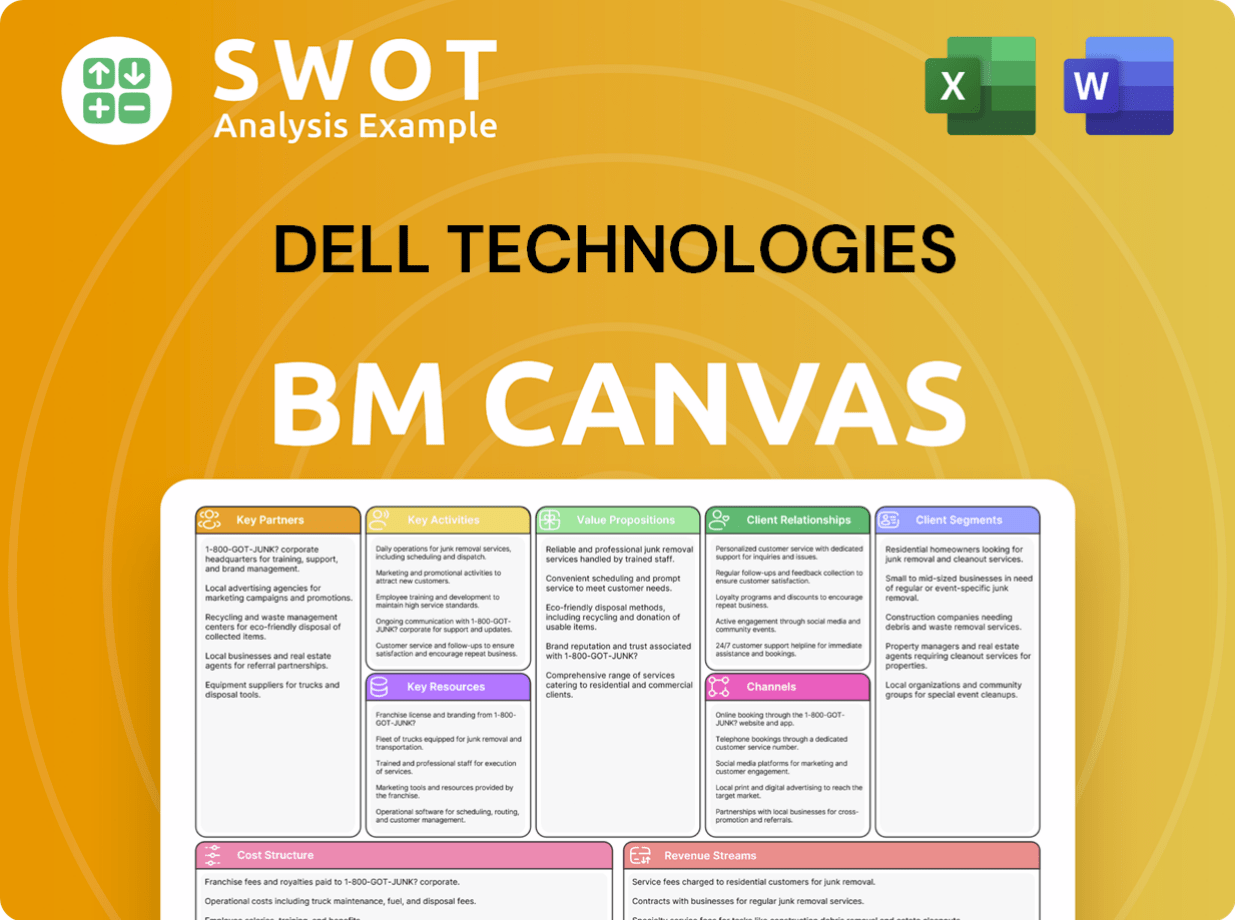
What Are Dell Technologies’s Most Notable Campaigns?
The company has consistently launched impactful sales and marketing campaigns to boost its brand recognition and market leadership. These campaigns often highlight its technological advancements and strategic partnerships, with a strong focus on artificial intelligence (AI) and its transformative role in computing. For instance, campaigns around 'AI PCs' aim to educate consumers and businesses on the benefits of integrated AI capabilities, enhancing productivity and creativity.
Another key area of focus is its enterprise solutions, particularly in data storage, servers, and cloud infrastructure. These business-to-business (B2B) campaigns emphasize performance, scalability, and security, often utilizing thought leadership content and direct sales team enablement. The company's commitment to sustainability is also a recurring theme, resonating with an environmentally conscious customer base.
The company's strategies involve clear objectives, such as driving awareness for new product categories, generating leads for enterprise solutions, and reinforcing brand values. Creative concepts showcase cutting-edge technology in action, demonstrating tangible benefits, and leveraging testimonials from satisfied customers. Channels include the company's website, social media platforms, industry publications, and targeted digital advertising. These efforts have contributed to the company's strong financial performance, with Q4 Fiscal Year 2024 net revenue of $22.3 billion, showcasing the effectiveness of its overall sales and marketing strategies.
The company has launched campaigns focused on 'AI PCs' to educate consumers and businesses about the benefits of integrated AI. These campaigns highlight enhanced productivity and creativity through AI capabilities. Digital channels, including online ads and social media, are used to showcase AI applications in their product lines.
B2B campaigns target enterprise solutions, emphasizing performance, scalability, and security in data storage, servers, and cloud infrastructure. These campaigns use thought leadership content, webinars, and direct sales enablement. The focus is on showcasing the company's leadership in these segments.
The company consistently communicates its commitment to sustainability, resonating with environmentally conscious customers. These campaigns often highlight the company's efforts to reduce its environmental impact and promote sustainable practices. This approach reinforces brand values and attracts customers who prioritize sustainability.
The company employs a robust digital marketing strategy, utilizing its website, social media (LinkedIn, X, Facebook), and targeted advertising. These strategies aim to drive awareness, generate leads, and reinforce brand values. The digital approach ensures broad reach and engagement.
The primary objectives of the company's campaigns include driving awareness for new product categories, generating leads for enterprise solutions, and reinforcing brand values. These objectives are crucial for maintaining market share and driving growth. Understanding the Growth Strategy of Dell Technologies is key to appreciating these campaigns.
- Increase awareness of AI PCs and their capabilities.
- Generate leads for enterprise solutions in data storage and cloud infrastructure.
- Reinforce the company's commitment to sustainability.
- Enhance brand recognition and market leadership.
Dell Technologies Porter's Five Forces Analysis
- Covers All 5 Competitive Forces in Detail
- Structured for Consultants, Students, and Founders
- 100% Editable in Microsoft Word & Excel
- Instant Digital Download – Use Immediately
- Compatible with Mac & PC – Fully Unlocked
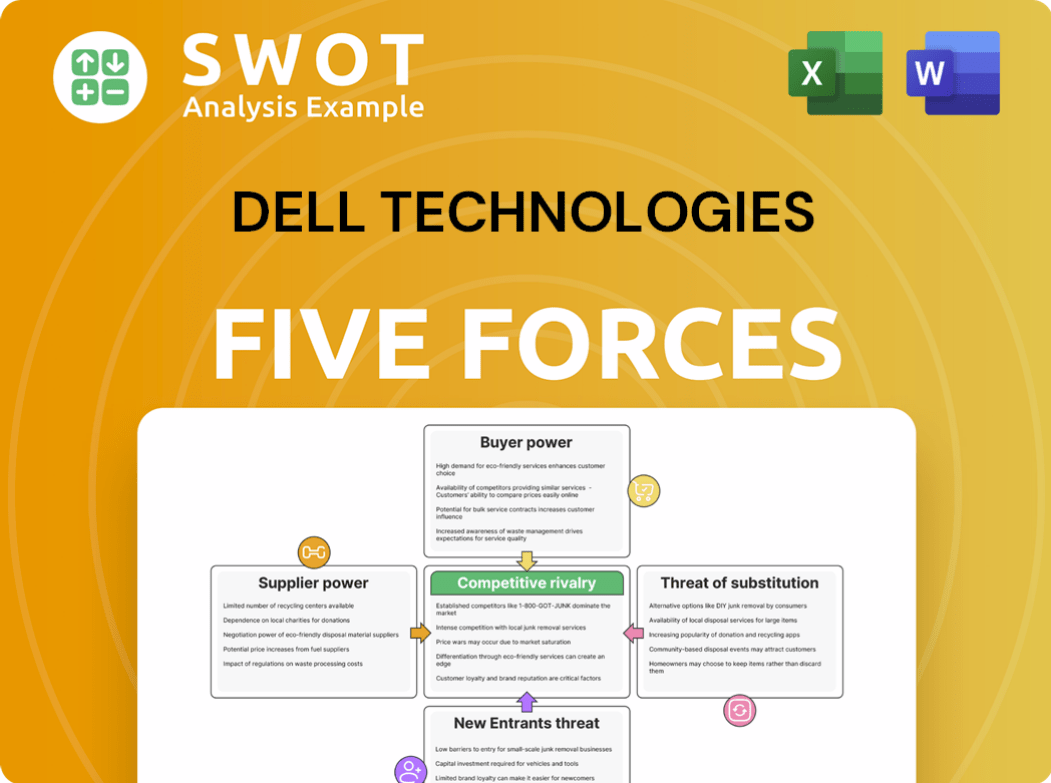
Related Blogs
- What are Mission Vision & Core Values of Dell Technologies Company?
- What is Competitive Landscape of Dell Technologies Company?
- What is Growth Strategy and Future Prospects of Dell Technologies Company?
- How Does Dell Technologies Company Work?
- What is Brief History of Dell Technologies Company?
- Who Owns Dell Technologies Company?
- What is Customer Demographics and Target Market of Dell Technologies Company?
Disclaimer
All information, articles, and product details provided on this website are for general informational and educational purposes only. We do not claim any ownership over, nor do we intend to infringe upon, any trademarks, copyrights, logos, brand names, or other intellectual property mentioned or depicted on this site. Such intellectual property remains the property of its respective owners, and any references here are made solely for identification or informational purposes, without implying any affiliation, endorsement, or partnership.
We make no representations or warranties, express or implied, regarding the accuracy, completeness, or suitability of any content or products presented. Nothing on this website should be construed as legal, tax, investment, financial, medical, or other professional advice. In addition, no part of this site—including articles or product references—constitutes a solicitation, recommendation, endorsement, advertisement, or offer to buy or sell any securities, franchises, or other financial instruments, particularly in jurisdictions where such activity would be unlawful.
All content is of a general nature and may not address the specific circumstances of any individual or entity. It is not a substitute for professional advice or services. Any actions you take based on the information provided here are strictly at your own risk. You accept full responsibility for any decisions or outcomes arising from your use of this website and agree to release us from any liability in connection with your use of, or reliance upon, the content or products found herein.